In this blog, I will document some project proposals for the final! All of these ideas would include mutual interactions with ‘Processing’ & ‘Arduino’! Below, I will go into a deeper analysis of each of them and explain its core message. Since my partner for the final is Calvin Lin, some ideas will overlap as we’ve already discussed these together. Though, it’s still informative and intuitive to hear from both sides’ perspectives and opinions.

Proposal 1- Jenga Edition: Truth or Dare
From children, to teenagers, and even adults, everyone is most familiar with the popular game ‘Jenga’. In this game, players take turns removing one wood block at a time from a built tower. Each block removed is then placed on top of the tower, creating a progressively more unstable structure. The goal of the game is to not tip the tower over, which the last person leading it to do so loses.
After discussing with me and my partner, we developed a creative idea (unique twist) to add more layers to the game itself. Instead of simply avoiding the tower falling, we added another popular party game called ‘Truth or Dare’ into this. Here, players are given the choice between either answering a question truthfully or performing an act. With these two elements, this game would now be interactive and extremely nerve-wracking.
We envisioned that each of the wood bricks (potentially made out of laser cutting) would have a scannable chip or QR code. By scanning this with their devices, a certain screen would display a card. Clicking the screen again would randomly generate a number between a certain value (potentially 0-50). Using this, the user would enter the number on Arduino’s serial monitor, resulting in a random selection of a ‘truth’ or ‘dare’.
Then, the Processing should also follow this response, showing either a ‘Truth’ or ‘Dare’ prompt on the screen. Then, a timer would automatically pop up, indicating the number of time users has to complete the task. If the prompt is ‘truth’, the user would have to say the truth in under 30 seconds. If the prompt is a dare, the user would have around a minute to complete it. If this fails to happen, the timer would ‘stop’ and create a losing sound through a buzzer (Arduino’s side). To make it more extreme, we could potentially link the blocks to servo motors, that push the blocks themselves. If the users can control their strength somehow, this would add another layer of challenge.
Overall, we are trying to accomplish a new playstyle of Jenga. Jenga can be too monochromatic, with the sole objective being to not tilt the tower over. However, with so many other drastic factors to constantly worry about, the difficulty of the game gets significantly broadened. Our main audience would be mostly teenagers and adults, as they typically enjoy these types of party/challenging interactive games. By implementing all these factors, we hope to create a more competitive environment for Jenga.

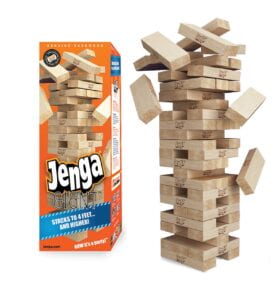
Drawing/Sketch:
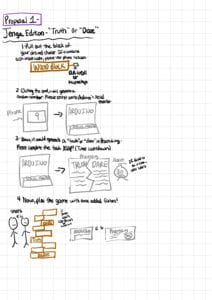
Proposal 2 – Protective Cube
Discussing this idea, me and my partner first asked ourselves how to create a form of ‘interactive cybersecurity’. Then, we created this idea of a safe-like box that enclosed classified information. To the owner of this device, solving each question would be time-consuming, but undoubtedly easy. After all, they would use extremely personal information that usually other people would not so easily have access to. This idea is similar to a virtual bank account verification, where a set of security questions is asked to proceed.
However, this interaction device would be more complicated. The cube-box would contain several locks that cannot be opened via key or physical item. Instead, it has to be through a number that only the owner would recognize. Now, you may ask, “How would we ever complete this task?”. To combat this, we envisioned using Arduino the protector, that locks the cube. To slowly open each of the locks, users would have to answer security questions in Processing. After each one, they would input these numbers into Arduino again, and proceed to open a lock. In the end, after all of the locks are solved, the box should open! The Processing screen should display this, similar to the ‘game-winning’ screen.
To add more factors to this, we could add different activities to spice this up. In conclusion, this protective cube serves as a ‘top-secret’ information protector. We are trying to accomplish an interactive yet difficult device to mock a setting of a ‘seemingly’ unbeatable safe. Though, we would obviously give different hints in Processing and relevant questions to encourage the users to complete the cube. We are catering this device to people who have classified information they wouldn’t want to ever be found out. For example, Mr. Krabs would use this to hide his Krabby Patty formula. This allows for the elements of cyber-security (Processing questions) and security (locks in cube) to combine together. By successfully recreating this, we hope to discover a new sense of security.
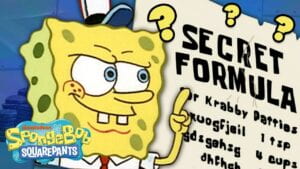
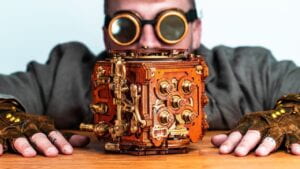
Drawing/Sketch:
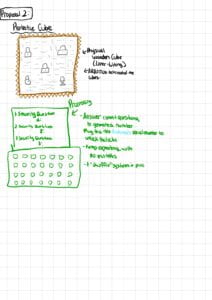
Proposal 3 — The Magician’s Hand
The interesting proposal is thought of by myself, as I wanted to think of something creative that is not normally envisioned. Here, I pictured an interactive device (preferably a glove) that can draw and create shapes when pointed at a screen. The name is referenced as it would look magical and something that only can be done through an optical illustration.
To do this, I would think of creating a device similar to the one in the ‘Workout Recitation’. When a limb is moved, it would activate sensors that correspond to Arduino’s serial monitor. To add it to a new element that we haven’t done yet, would create an effect on Processing itself. Therefore, Arduino would talk to Processing about this idea. The device would communicate with Arduino — the Arduino would talk with Processing — and finally, Processing would send out a visual form of communication.
By doing this, I want to create a visual art opportunity while making it simultaneously interactive. By changing certain elements, the user should also be able to choose the color, shape, form, and weight of the design. This might be able to be done using different hand gestures, similar to the ones on Apple devices. It would essentially become a virtual pencil (with your fingerprint) that correlated with a user’s every move. At the beginning of the semester, there was a device that allowed disabled people to draw using tracked eye movements. Here, I will link a Youtube Video that shows this brilliance in a similar effect. Instead of the eyes, we would use fingers to create the same effect.
In conclusion, this would add a unique twist to the device as it’s hard to recreate. The project is trying to allow people to accomplish a form of communication without needing to use any sort of tools (pencils, pens, crayons, etc). For disabled people, this might be helpful if they want to use their hands to quickly communicate! In fact, successfully coordinating this could allow this device to not only be incorporated into hands, but also potentially expand to other body parts. While this would be extremely difficult to accomplish, it might be worth a try!

Sketch/Diagram:
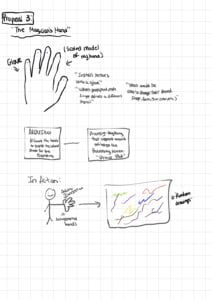
Leave a Reply